How To Monetize A Website In 2024: 15 Proven Strategies

Ready to start making money from your site?
In this post, we’ll be teaching you how to monetize a website effectively this year.
We’ll cover 15 proven website monetization strategies that can make you thousands of dollars every month and show you how to implement them.
Plus, we’ll also share some real-life examples of different strategies so you can see what they look like in action.
Let’s get into it.
1. Launch an online course
One of the best and most underrated ways to monetize your site is to create and sell an online course. Here’s why.
First off, online courses have incredible profit margins. You only have to create a course once, but you can sell access to that course over and over again through your site, as many times as you want.
There are no manufacturing costs and almost zero overheads, so pretty much 100% of your sales revenue is profit. And the most successful course creators earn tens of thousands of dollars in revenue every single month.
Secondly, it’s easy to do. You can build your course in no time using an online course platform like Thinkific.
Thinkific takes care of all the heavy lifting for you by building your course pages, course player, student login pages, etc. All you have to do is create your curriculum structure in the built-in course creator by adding units and lessons.
Next, you can add multimedia content to your lessons like videos, downloadable files, quizzes and assignments, etc. Then, set your pricing and course delivery options and publish it to your site.
Once you’ve created your course, you can start advertising it on your website to drive enrollments.
The key to success here is to make sure you create a course that fits with your existing website traffic.
If your website is all about health and fitness, you could create a course teaching people about nutrition, as that’s likely to resonate with your audience. If your website is a blog about photography, you could create a beginner’s photography course. You get the idea.
Take Income School, for example.

Their blog and YouTube channel are all about digital marketing, blogging, and SEO. And they monetize that audience by selling subscriptions to their Project 24 course, which teaches content creators how to do SEO effectively and drive more organic traffic.
With hundreds of course members, they’re now earning tens of thousands of dollars in subscription revenue.
2. Earn commissions through affiliate marketing
Affiliate marketing is when you get paid commissions for referring sales to another online retailer.
Probably the most famous example of this is Amazon Associates – the largest affiliate marketing program in the world.
Website owners can sign up for Amazon Associates and start promoting products from Amazon on their site via unique referral links.
If one of your visitors clicks one of your referral links and buys something from Amazon within the cookie window, you get paid a fraction of the sales price in commission.
Of course, Amazon Associates is just one of many affiliate programs. And to be honest, it isn’t even one of the best as it doesn’t offer great commission rates.
You can find much better opportunities on affiliate networks. We’d recommend starting with ShareASale.
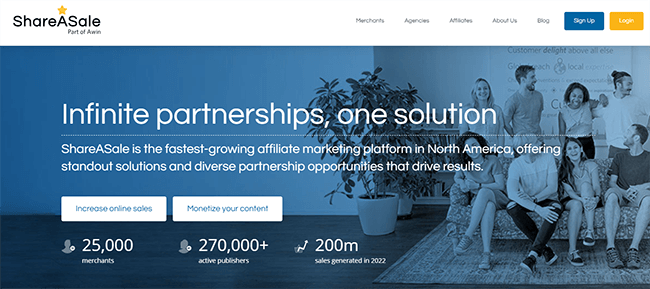
Browse the programs on ShareASale and look for a product/service that fits your niche. It should be something you’d feel comfortable recommending, and that you think your site audience would be interested in.
And ideally, it should offer good commission rates. 10%-20% is about average, but some of the best opportunities offer commission rates of 50%+.
The best way to promote an affiliate link through your site is to publish blog posts that generate targeted, buyer-intent traffic.
For example, a review of the product you’re promoting is a good place to start. Relevant product roundup posts, comparison posts, and alternative posts are other good ideas.
3. Branch out into ecommerce
An even better idea than selling somebody else’s products via affiliate marketing is to sell your own products through your website.
That way, you won’t just earn 10-20% per sale in commissions—you get the whole 100%.
No matter what your website niche is, you should be able to find products that your audience would be interested in.
For example, fitness blogs could sell protein powders and gym equipment. Beauty blogs could sell skincare and makeup products. Pet blogs could sell dog toys or pet food products. You get the idea.
You’ll need an ecommerce platform to start selling products. Shopify is the leading ecommerce platform, but Sellfy is the best for simplicity.
You can build a fresh new ecommerce store using either of the above, and then drive traffic to it from your existing website by embedding buy buttons, etc.
Alternatively, if your existing website is built on WordPress, you could add ecommerce functionality to it by installing and activating the WooCommerce plugin.
Soko Glam is a great example of an ecommerce store done right.
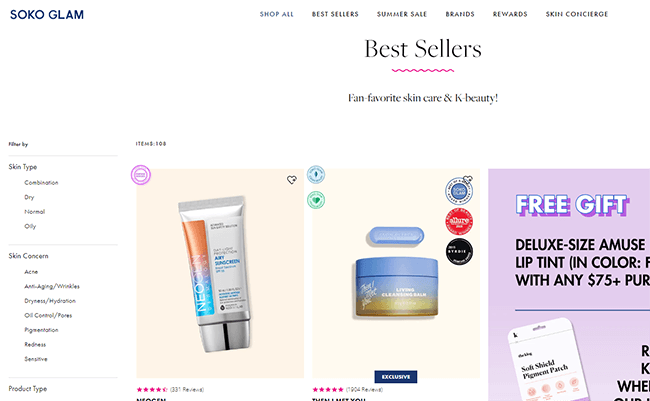
They sell Korean skincare and beauty products and drive traffic to their store through their super-popular blog, The Klog, where they publish informative posts about all things K-beauty.
4. Start dropshipping
Don’t want the hassle of managing inventory and handling fulfillment? Start a dropshipping store instead.
Dropshipping is a particular type of ecommerce that’s a lot more hands-off. You don’t need to buy any stock upfront or worry about things like shipping.
It works like this. First, you sign up for a dropshipping website that connects you with dropshipping suppliers. We’d recommend Spocket.
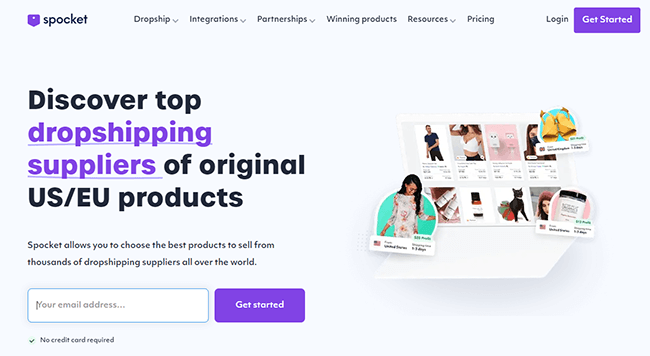
Once you’ve connected Spocket to your website, browse its product catalog to find products you want to sell, and add them to your store in a couple of clicks.
Whenever you sell one of those products, you can automatically send the order details through to the supplier. And the supplier will ship the product directly to the customer for you.
Because you only pay the supplier after the customer has already paid you, it’s totally risk-free. The difference between the price you sell for and the price you buy for is your markup/profit margin.
5. Sell print-on-demand merchandise
Print-on-demand is a lot like dropshipping. But the difference is you’ll be selling products that have been printed with your own custom designs.
I’m talking about things like branded t-shirts, mugs, phone cases, tote bags, etc.
As with dropshipping, you don’t need to purchase anything upfront. All you have to do is sign up for a print-on-demand site (we’d recommend Gelato) and connect it to your website/online store.
Then, pick out some blank products from their catalog that you’d like to sell, and upload your designs to them (or use the built-in design tools to create them from scratch).
If you’re not sure what kind of designs to create, simply adding your website logo to products is a good place to start.
Once you’ve selected products and uploaded your designs to them, you can import them to your website in a couple of clicks, and then start selling them at whatever price you choose.
When you make a sale, the order will be automatically sent through to Gelato (or whichever print-on-demand provider you’re using). They’ll print the product on-demand from the nearest production center to the customer and ship it directly to them.
They handle all the fulfillment and customer service, so it’s super hands-off for you. And as with dropshipping, you’ll only pay your print-on-demand provider for the product after your customer has already paid you, so it’s pretty much risk-free.
Sunshine is a great example of a site that sells print-on-demand products.
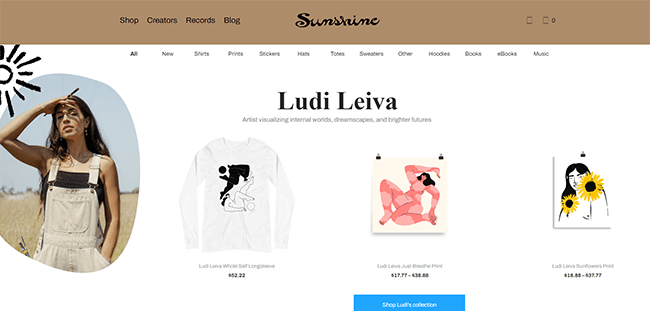
Their fresh designs made by some of the best up-and-coming artists have made their store a roaring success, and they now reach an audience of over 1.4 million
6. Sell digital products
Selling digital products is another really great way to monetize your website. I’m talking about things like ebooks, PDFs, images, videos, and other kinds of digital downloads.
Digital products like these offer much better margins than physical products, and they’re much easier to sell as you don’t need to worry about things like inventory or shipping.
To get started, you’ll first need to think about what kind of digital products you might be able to sell to your audience. Check out our roundup of the best digital products to sell online for some ideas.
Then, you’ll need to sign up for an ecommerce platform that supports digital products. Sellfy is a good option, as is Podia.
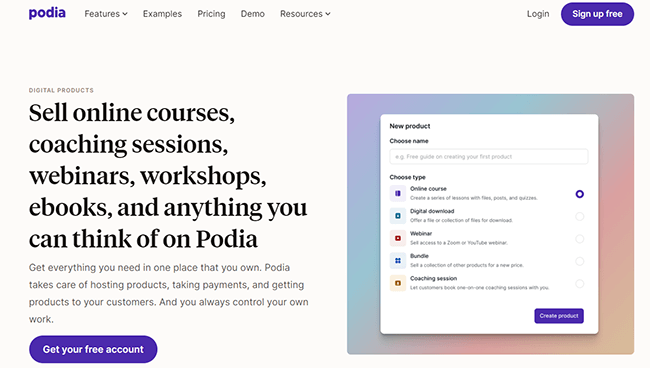
From there, the next step is to upload your digital product to your store and set your pricing, licensing terms, etc., then start selling.
7. Promote paid webinars & live streams
Another way to monetize your site is to host paid webinars and live streams.
You’ll need to use a webinar platform to host your streams. Then, you can use your site to promote it and collect attendee registrations.
We’d recommend using Webinar Ninja as it’s affordable and packed with useful features, like the ability to save webinars for replays and on-demand streams.
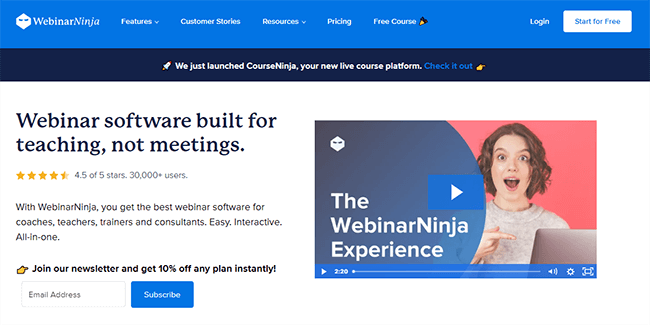
8. Collect donations from your readers
Don’t want to sell anything to your readers? Just ask for donations instead.
You’d be surprised at how often readers will jump at the chance to support their favorite websites. Especially if you’re providing them with valuable content for free.
But even if only 1% of your audience chooses to donate, if your site gets 100k visits a month, that’s still 1,000 donations.
And if each of those patrons donates just five bucks, that’s $5,000 a month. Pretty good, right?
To start accepting donations, just create a page on Buy Me A Coffee. It takes less than a minute to set up and it’s totally free.
We have our own Buy Me A Coffee page, which we link to in the footer of Blogging Wizard to make it easy for readers to donate.
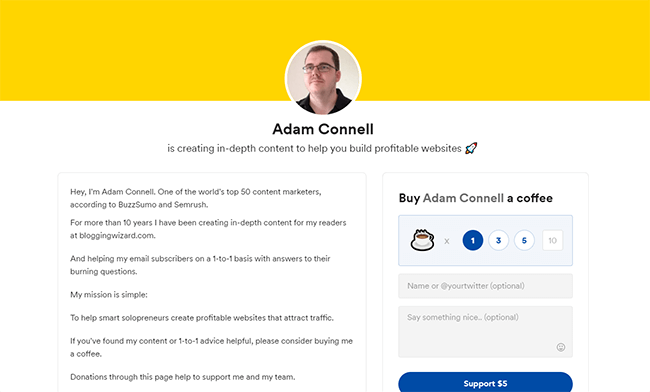
We’ve had plenty of grateful readers buy us a coffee so far, and while not expected, they’re always much appreciated!
9. Build a membership site
Another way to monetize your site is to build a members-only area and sell subscription memberships.
Not only does this provide a revenue stream for you, but it also helps to build brand loyalty and increase engagement.
You can offer perks to your site’s paid members, like access to exclusive premium content that regular readers can’t access.
And you can even set up a members-only forum or discussion board on your site, where your subscribers can interact with each other and leave comments, questions, etc.
If your site is built on WordPress, you can use one of these WordPress membership plugins to set everything up. We’d recommend MemberPress.
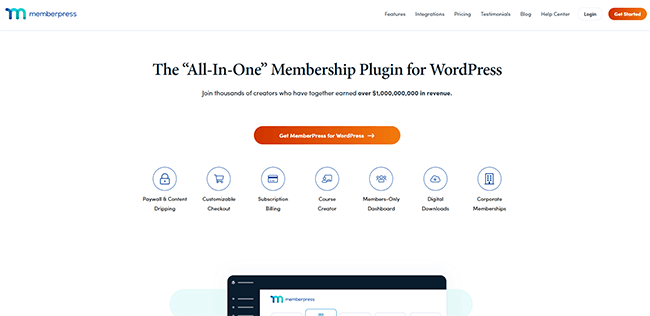
10. Monetize your website with ads
Running advertisements on your site is one of the most straightforward ways to monetize.
It doesn’t pay quite as much as some of the other monetization methods on this list, but it’s easy to implement and a good way to boost your earnings.
The easiest way to get started is to sign up for an ad network. Once you’ve connected it to your site, the ad network will serve up relevant ads to your visitors, and you’ll be paid per click or per thousand impressions.
Google Adsense is the most popular ad network, but a lot of bloggers and website owners think it doesn’t pay as well as it should. You may be able to earn more revenue with alternatives like Ezoic.
Aside from ad networks, you can also try selling ad space on your site directly to companies. That way, you’ll have more control, and you can often negotiate better contracts. But it’s also a lot more work.
Pretty much every news outlet relies on ads as one of their main sources of revenue. For example, look at UK newspaper The Independent.

Its website is full of ads, including full-screen border ads, sidebar ads, banner ads, in-line ads, video ads, native ads, and more.
11. Sell sponsored posts
Selling sponsored posts is another one of the most common ways publishers monetize their sites.
With sponsored posts, brands pay you to publish a blog post on your site promoting their product/service/business. Sometimes, they might provide the content and you just publish it. Other times, you’ll both produce and publish the post.
It’s up to you how much you charge for sponsored posts. Depending on the size of your audience, you could charge anywhere from a hundred bucks to several thousand dollars.
Make sure you set clear terms and agree on things like how long the post will be up for, the links it will include, etc. beforehand.
Also, keep in mind that FTC guidelines require you to disclose sponsored content. Most bloggers do this by adding a ‘sponsored post’ disclaimer at the top of the page, but do your own research and make sure you’re compliant with all relevant requirements.
To start selling sponsored posts, create a page on your site where you advertise sponsorship opportunities and provide a contact email address. A lot of websites link to this in the navigation bar under a heading like ‘work with us’, but you can also just add the information to your contact page.
12. Create a paid newsletter
Most bloggers already have some sort of free newsletter that they send out to subscribers to notify them of new posts. So why not have a paid newsletter too?
A lot of readers are willing to pay for newsletters, as long as it gets them access to exclusive, premium content that’s worth paying for.
You can use email marketing software like MailerLite to set up your newsletter.
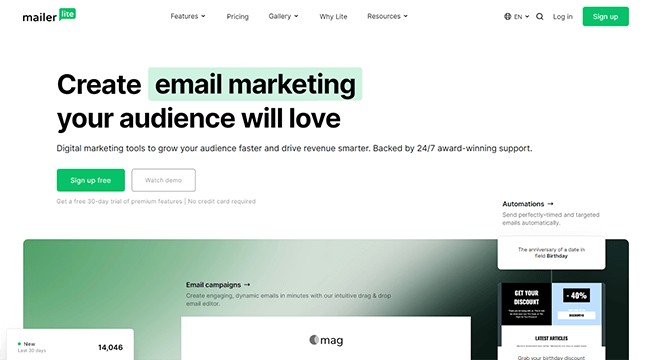
It gives you all the tools you need to grow your mailing list, sell subscriptions, design your emails, and automate your campaigns.
13. Add a job board to your site
This is another lesser-known monetization strategy that can work super well, depending on your niche.
You see, there are a lot of companies out there that offer referral programs, in which you get paid commissions when you help them hire new qualified employees.
You can turn this into a monetization opportunity by adding a relevant job board to your site, in which you advertise job openings using your unique referral links.
Obviously, the way to make this work is to only include jobs that are relevant to your audience. For example, if your website is a blog all about graphic design, you could include job openings for graphic designers.
A good example of this is Digino.
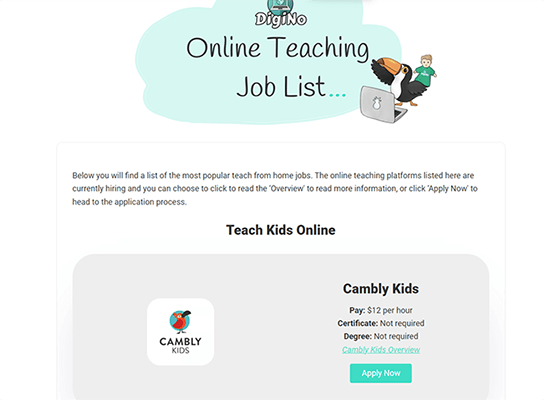
Digino’s a blog all about online teaching, and working from home. So on their site, they’ve included an online teaching jobs list, through which readers can apply to teach with all the big online ESL companies.
Most of these companies offer generous referral programs offering bonuses of $20-$100 for every new hire their affiliates refer. And as a result, Digino makes hundreds of dollars a month in referral income.
14. Sell services
We’ve already talked about how you can monetize your site by selling products and digital downloads. Another option is to sell services.
For example, if your blog is considered an authority in your niche, and you’re seen as an expert in your field, you could sell consultancy services. This is what Neil Patel does.
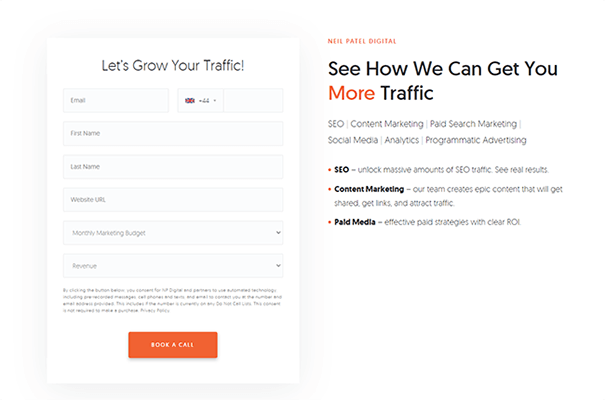
Another option is to sell writing or marketing services. If you have a successful blog that gets traffic, then your website is already evidence that you know how to write great content that ranks. And a lot of other businesses will be willing to pay for someone with those skills.
If you want to go down this route, make a ‘hire me’ page and link to it in your site navigation bar.
15. Cross-promote other monetized channels
If you’re struggling to monetize your website effectively, use it to promote other channels that you can monetize instead.
For example, a lot of creators find it easier to monetize their YouTube videos than their website. In that case, you can promote your YouTube channel on your website to drive traffic to it and get more subscribers.
Alternatively, you could add a popup on your site inviting readers to follow your socials. Then once you’ve built a social following, you can monetize that through sponsored posts, etc. Check out our guide on how to make money on Instagram for more information on this.
Final thoughts
That concludes our guide on how to monetize a website this year.
All of these strategies can be a great way to make money through your site. Test them out and see which ones work best for you.
And remember: There’s no reason to just stick to one. It’s often worth using multiple monetization strategies in tandem. That way, you’ll have more income streams to generate income.
You also don’t need to wait until you reach a particular amount of visitors to use most of these tactics. Sure, there will be specific requirements with certain ad platforms and you’ll always do better with more visitors. But you don’t need to wait for most of them.
Related reading:
- How Do Influencers Make Money? The Complete Guide
- The Best Ways To Monetize Your Blog (And Why Most Bloggers Fail)
Disclosure: Our content is reader-supported. If you click on certain links we may make a commission.
